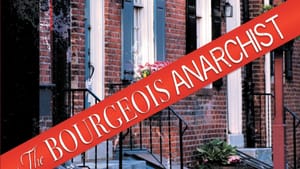Waiting for the revolution
The Bourgeois Anarchist by Sam Gridley

In The Bourgeois Anarchist, long-time activist Susie Alioto is injured by a seemingly random act of violence during a protest on Market Street, setting off a series of events that makes her question whether her long-held principles work in 21st-century Philadelphia. Sam Gridley's novella explores the contradictions one aging radical encounters while living within capitalism.
Susie is pleasant to spend time with, and for a general reader, Gridley’s book is an easy introduction to some of the intellectual and moral depth of anarchist thought. I was drawn in by personal resonances with the character. She is roughly my age, and like me came very late to parenthood. I was also involved with anarchist activity in my youth and in recent years have returned to a sort of activism.
The opening scene of the book, in which tensions at a Center City demonstration are pushed to violence by black-clad anonymous individuals rushing through the crowd, shouting about police violence, brought back memories of a march after the 2016 elections, when a few such individuals almost created a panic near me. But the book already feels mildly dated, as if it had been written in 2016. It’s set in a pre-pandemic, pre-George Floyd Philadelphia, and there is no mention of our last president, which feels unbelievable for any radical in recent years.
Taking anarchy seriously
Gridley obviously takes anarchism seriously as a philosophy, and the most important conflict in the novella revolves around the difference between Susie’s anarchism and the version espoused by the Black Bloc wannabes Susie gets involved with after the demonstration. Susie is particularly influenced by the Italian Errico Malatesta (1853-1932). The book’s first epigraph is Malatesta’s description of the “anarchist spirit … which aims at the good of all, freedom and justice for all,” and “inspires all people who have a generous heart and an open mind.” She keeps a poster of him on her refrigerator and named her son after him (to her son’s great annoyance), and the reader of The Bourgeois Anarchist gets a good introduction to Malatesta’s life and thought.
Susie spent 18 years living in a West Philly commune, but for the last 25 years she’s taught at a private school, which got her son a scholarship and allowed her to buy a rowhome in Fairmount. Now Susie goes to protests with a group of teachers called TeachPeace, which is why her son Eric nicknames her “the bourgeois anarchist.”
After Susie is hurt, a young woman in a balaclava comes to her aid. This is Lauren, who is part of a radical groupuscule lead by Sean, a paranoid, charismatic sociopath. It was Sean who broke the window of the new Gentle Grounds coffeehouse, and Susie is not the only one who is injured. This news propels Susie into the orbit of the café owner’s family, with consequences that lead to both late-life romance and violence, forcing Susie to decide between Malatesta’s credo that “a policeman is worse than a criminal” and trying to stop individuals she believes are dangerous to society.
How does the revolution arrive?
We meet a number of interesting characters along the way and learn a lot about Malatesta and Susie’s past. In the end, though, nothing much seems to happen. Susie has a long-foreshadowed medical crisis, violent actors escape criminal prosecution, and Susie’s effect on the people around her is limited.
This is because Susie’s anarchism is not revolutionary, or even particularly political. Rather, it’s aptly described in the novella’s second epigraph, from historian James Joll: “Anarchism is both a religious faith and a rational philosophy; and many of its anomalies are the product of the clash between the two.” This description leaves out the political, and Susie’s crises are ultimately reduced to individual moral quandaries. She is indeed a “bourgeois anarchist.” She fits snugly within an all-too-common white middle-class liberal profile: although she’s been involved in leftwing political action in Philadelphia for nearly half a century, Susie’s social world seems entirely white, cis, and straight: the only nonwhite characters in the book are a police detective and the café owner.
Gridley ends his acknowledgements by saying “When the revolution finally arrives, folks like … Ms. Alioto will rule.” If a future society of mutual aid and community-based direct democracy ever do arrive, I would be happy to see many decisions from elders like Susie Alioto. I’m grateful to Sam Gridley for introducing me to her, and re-introducing me to Errico Malatesta. But if one agrees to this vision, a huge question remains: how are we to get there?
What, When, Where
The Bourgeois Anarchist. By Sam Gridley. Georgetown, KY: Finishing Line Press, 2021. 140 pages, $20.99. Get it on bookshop.org.
Sign up for our newsletter
All of the week's new articles, all in one place. Sign up for the free weekly BSR newsletters, and don't miss a conversation.

 Walter Bilderback
Walter Bilderback